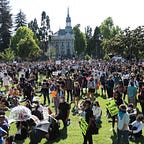People’s Park ~ A 50-year Struggle Against State Violence
The year was 1967. Berkeley’s vibrant counterculture included anti-war and free speech activists, the Black Power Movement and Cal students from across the country. The square block along Telegraph, Bowditch, Haste and Dwight Way — soon to become People’s Park — was a nucleus of counterculture activity. A thriving community of small businesses, musicians, writers, residents of the large shingled homes on the block and students created organizations like the Ecology Action Center, which planted flowers and served free meals.
Determined to halt the counterculture, the Regents applied eminent domain. Residents were evicted. Homeowners were paid less than half the market value for their homes. Once vacated, bulldozers levelled the area. Soon thereafter, UC abandoned its plan to build a sports complex and the site degenerated into a trash heap.
Community members petitioned the city to allow for a park. The city, aligned with the university’s interests, took no action.
In April of 1969, the independent newspaper the Berkeley Barb printed a call to build the park by hand. Funds were raised and crowds of old and young, professors, hippies, revolutionaries and students of many races and religions joined in a common vision and collective design. People’s Park was born!
From its inception, the park was an affront to the state and to capitalist ideology. Governor Reagan vowed to destroy the movement in Berkeley. UC Berkeley Chancellor Roger Heyns gave the order to clear the property on May 15, 1969. Berkeley police and the California Highway Patrol escorted bulldozers that blocked the park. A chain link fence was erected.
In response, students organize with the rallying cry ”take back the park.” Thousands gather in the streets and rooftops around People’s Park. The police used tear gas and rubber bullets to disperse crowds. State troopers and sheriff deputies employed live ammunition.
James Rector was killed when bullets pierced his aorta. Hundreds were wounded. Reagan mandated a military camp at the Marina, while peaceful protesters spilled off campus into the streets. The battle lasted 16 days. On May 30,1969, Reagan retreated, withdrawing the National Guard.
Today, the university continues its colonialist, militarist approach by erecting fences and threatening this historic site.
Over 150 people currently shelter at the park. When the encampment sweeps began in August, more moved there highlighting People’s Park’s value as a unique sanctuary.
Let’s celebrate the tradition of ecologists and peace lovers who created the park and stand united with those who gave so much. Let’s demand accountability for those who lost homes and businesses in 1969. Let’s end the unnecessary, costly, and deadly conflict and demand that People’s Park be preserved as a historic site.
People’s Park Historic District Advocacy Group submitted a nomination to the National Register of Historic Places. To see the application, go to https://tinyurl.com/cr2f2vsy.
Please submit written comments prior to October 14, 2021 to:
Attn: Office of Historic Preservation, Julianne Polanco State Historic Preservation Officer, 1725 23rd Street, Suite 100, Sacramento, California 95816
This article was first published in the Berkeley Times on September 9, 2021.
